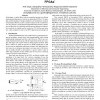Free Online Productivity Tools
i2Speak
i2Symbol
i2OCR
iTex2Img
iWeb2Print
iWeb2Shot
i2Type
iPdf2Split
iPdf2Merge
i2Bopomofo
i2Arabic
i2Style
i2Image
i2PDF
iLatex2Rtf
Sci2ools
ICCAD
2001
IEEE
2001
IEEE
Interconnect Resource-Aware Placement for Hierarchical FPGAs
In this paper, we utilize Rent’s rule as an empirical measure for efficient clustering and placement of circuits on hierarchical FPGAs. We show that careful matching of design complexity and architecture resources of hierarchical FPGAs can have a positive impact on the overall device area. We propose a circuit placement algorithm based on Rent’s parameter and show that our clustering and placement techniques can improve the overall device routing area by as much as 21% for the same array size, when compared to a state-of-art FPGA placement and routing tool.
Circuit Placement Algorithm | Hardware | Hierarchical Fpgas | ICCAD 2001 | State-of-art Fpga Placement |
| Added | 17 Mar 2010 |
| Updated | 17 Mar 2010 |
| Type | Conference |
| Year | 2001 |
| Where | ICCAD |
| Authors | Amit Singh, Ganapathy Parthasarathy, Malgorzata Marek-Sadowska |
Comments (0)

